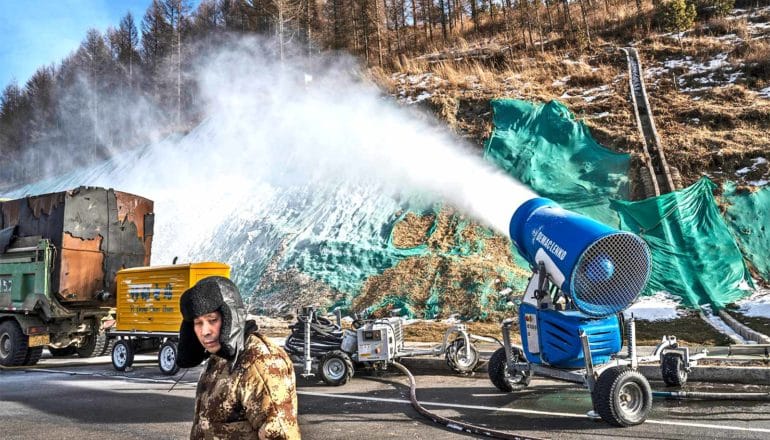
Shorter winter seasons, less snowfall, and melting ice caused by climate change will have major implications for the 2022 Beijing Winter Olympics and the future of winter sports, according to a new report.
Changing snow conditions have made it increasingly difficult for host cities to have enough snow for athletes to participate in their respective winter sports. To address this, Japanese scientists invented a formula for artificial snow that’s been in use since the 1980 Winter Games in Lake Placid, New York.
This year’s games in Beijing will be the first to use almost 100% artificial snow, requiring an estimated 49 million gallons of water, 130 fan-operated snow generators, and 300 snowmaking guns to create the 1.2 million cubic meters (about 42,377,600 cubic feet) of snow, according to the report.
“For everything to work, event organizers need to be able to access a huge supply of water and to power all that equipment. And even still, they need favorable weather conditions to keep the artificial snow in optimal conditions—after all, even fake snow melts,” says associate professor Tim Kellison, co-director of Georgia State University’s Center for Sport and Urban Policy and a coauthor of the report.
“The process of artificial snowmaking itself can come at a heavy environmental cost, especially because of all the water that’s used. But all of this infrastructure also costs a lot of money, something an Olympic host city might be able to absorb, but less possible at lower levels of these winter sports.”
Artificial snow not only requires significant resources and infrastructure to create, but it also has an impact on winter athletes’ ability to train and safely compete.
“I’ve noticed an increase in mental health issues around snow sport athletes. We also see more injuries caused by the lack of practice on snow and the added pressure to perform when there is a window of opportunities,” says Philippe Marquis, a two-time Winter Olympian and top freestyle skier, in the report. “Athletes feel the urge to push their limits even if the conditions are suboptimal.”
Kellison and his colleagues recommend that athletes, scientists, and Olympic planning committees take environmental concerns and sustainability into consideration when choosing future locations for the Winter Olympics and Paralympics.
They also suggest conducting more in-depth research about the effects of using artificial snow and the optimal environments for training and competing in winter sports.
“We expect that the changing climate is only going to increase the reliance on artificial snowmaking, so it’s going to be important to understand how snowmaking can be achieved efficiently and in a way that limits its environmental impact,” Kellison says.
“It’s also necessary to ensure that those on the snow—whether they’re on the slopes for the first time or racing down a mountain in an Olympic-medal run—are safe.”
Source: Georgia State University
The post Almost all the snow at the Winter Olympics will be fake appeared first on Futurity.
from Futurity https://ift.tt/634Jkm7hp
No comments:
Post a Comment